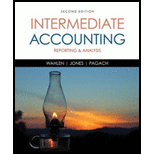
Intermediate Accounting: Reporting and Analysis
2nd Edition
ISBN: 9781285453828
Author: James M. Wahlen, Jefferson P. Jones, Donald Pagach
Publisher: Cengage Learning
expand_more
expand_more
format_list_bulleted
Question
Chapter 2, Problem 1GI
To determine
Provide the conceptual framework of the FASB.
Expert Solution & Answer
Explanation of Solution
Financial Accounting Standards Board (FASB):
The Financial Accounting standards Board (FASB) is the primary standard-setting body in the Country U. It is responsible for establishing Generally Accepted Accounting Principles (GAAP), which acts as a guide at the time of preparation of financial statements by enterprises.
- The main intent of the conceptual framework of the FASB is to establish objectives and fundamental concepts so as to help in development of the
financial accounting and their reporting guidance. - The conceptual framework of FASB has laid foundation of objectives, concepts, principles and definitions which helps in leading a high –quality financial accounting standards and the appropriate application of those standards in accounting practice.
- The objectives serve as a guideline in accomplishing the goals and purpose of the financial reporting. The underlying concepts of the financial accounting guides in selection of the transaction and events that are to be accounted for, their recognition and measurements and the means of summarizing and communicating the given information to the financial statement users.
Want to see more full solutions like this?
Subscribe now to access step-by-step solutions to millions of textbook problems written by subject matter experts!
Students have asked these similar questions
Ques 8
Can you solve this general accounting problem using accurate calculation methods?
Can you explain the correct approach to solve this general accounting question?
Chapter 2 Solutions
Intermediate Accounting: Reporting and Analysis
Ch. 2 - Prob. 1GICh. 2 - Prob. 2GICh. 2 - How do accounting concepts, principles, standards,...Ch. 2 - Prob. 4GICh. 2 - Prob. 5GICh. 2 - Prob. 6GICh. 2 - What is the Objective: Useful Information about...Ch. 2 - Prob. 8GICh. 2 - Prob. 9GICh. 2 - Define (a) return on investment, (b) risk, (c)...
Ch. 2 - Prob. 11GICh. 2 - Prob. 12GICh. 2 - Prob. 13GICh. 2 - Prob. 14GICh. 2 - Prob. 15GICh. 2 - Prob. 16GICh. 2 - What is the cost constraint, and how does it...Ch. 2 - Prob. 18GICh. 2 - Prob. 19GICh. 2 - Prob. 20GICh. 2 - Prob. 21GICh. 2 - Prob. 22GICh. 2 - Prob. 23GICh. 2 - Describe accrual accounting. What are the...Ch. 2 - What drives the timing of revenue recognition?...Ch. 2 - Prob. 26GICh. 2 - Prob. 27GICh. 2 - Prob. 28GICh. 2 - Prob. 29GICh. 2 - The information provided by financial reporting...Ch. 2 - Which of the following is considered a constraint...Ch. 2 - According to Statement of Financial Accounting...Ch. 2 - Prob. 4MCCh. 2 - Prob. 5MCCh. 2 - Prob. 6MCCh. 2 - Accruing net losses on obsolete inventory is an...Ch. 2 - Prob. 8MCCh. 2 - An accrued expense is an expense: a. incurred but...Ch. 2 - Prob. 10MCCh. 2 - Prob. 1ECh. 2 - Prob. 2ECh. 2 - Prob. 1CCh. 2 - Prob. 2CCh. 2 - Prob. 3CCh. 2 - Prob. 4CCh. 2 - An accountant must be familiar with the concepts...Ch. 2 - Prob. 6CCh. 2 - Prob. 7CCh. 2 - Prob. 8CCh. 2 - Prob. 9CCh. 2 - Accruals and Deferrals Generally accepted...Ch. 2 - Prob. 11CCh. 2 - Prob. 12CCh. 2 - You have been hired as an accounting consultant by...Ch. 2 - Prob. 14C
Knowledge Booster
Similar questions
- I am looking for the correct answer to this general accounting problem using valid accounting standards.arrow_forwardI am trying to find the accurate solution to this general accounting problem with appropriate explanations.arrow_forwardPlease provide the answer to this general accounting question using the right approach.arrow_forward
arrow_back_ios
SEE MORE QUESTIONS
arrow_forward_ios
Recommended textbooks for you
 Intermediate Accounting: Reporting And AnalysisAccountingISBN:9781337788281Author:James M. Wahlen, Jefferson P. Jones, Donald PagachPublisher:Cengage Learning
Intermediate Accounting: Reporting And AnalysisAccountingISBN:9781337788281Author:James M. Wahlen, Jefferson P. Jones, Donald PagachPublisher:Cengage Learning Accounting Information SystemsAccountingISBN:9781337619202Author:Hall, James A.Publisher:Cengage Learning,
Accounting Information SystemsAccountingISBN:9781337619202Author:Hall, James A.Publisher:Cengage Learning, Intermediate Financial Management (MindTap Course...FinanceISBN:9781337395083Author:Eugene F. Brigham, Phillip R. DavesPublisher:Cengage LearningPrinciples of Accounting Volume 1AccountingISBN:9781947172685Author:OpenStaxPublisher:OpenStax College
Intermediate Financial Management (MindTap Course...FinanceISBN:9781337395083Author:Eugene F. Brigham, Phillip R. DavesPublisher:Cengage LearningPrinciples of Accounting Volume 1AccountingISBN:9781947172685Author:OpenStaxPublisher:OpenStax College

Intermediate Accounting: Reporting And Analysis
Accounting
ISBN:9781337788281
Author:James M. Wahlen, Jefferson P. Jones, Donald Pagach
Publisher:Cengage Learning

Accounting Information Systems
Accounting
ISBN:9781337619202
Author:Hall, James A.
Publisher:Cengage Learning,



Intermediate Financial Management (MindTap Course...
Finance
ISBN:9781337395083
Author:Eugene F. Brigham, Phillip R. Daves
Publisher:Cengage Learning

Principles of Accounting Volume 1
Accounting
ISBN:9781947172685
Author:OpenStax
Publisher:OpenStax College